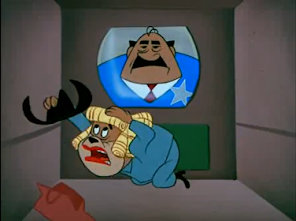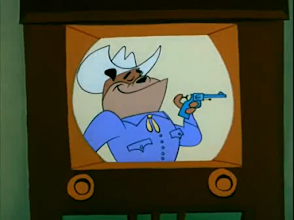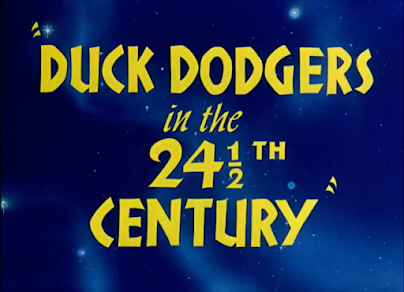Cartoon comedy: "Cellbound"
In Cellbound (MGM, 1955), directors Tex Avery and Michael Lah, and writer/story artist Heck Allen, created a great comic setpiece.
An escaped prisoner (that bulldog with the pseudo-Irish accent from a lot of Tex Avery's cartoons) has hidden inside a hollowed-out TV, only to find that it has just been purchased by the prison warden who had been guarding his cell for the past several years.
In order to avoid being caught, he has to act out various TV shows convincingly enough that the warden will believe he's watching the real TV shows and won't get suspicious.
The comedy comes from his desperation at this challenging task. If he could just do like so many cartoon characters do and produce props and backdrops by reaching off-screen, behind his back or into a pocket that they couldn't possibly fit in... then his task would be easier, and less entertaining for us.
Avery and co. make it clear in advance what limited resources the bulldog has. As he escapes his cell, he packs a bag with "disguises", mostly hats and wigs, and he wears one of the wigs when he hollows out and hides inside the TV. Inside the TV, when he panics as the thought of being discovered by the warden, he glances over at the bag. This establishes the rules of the upcoming scenes: all he has is himself and what he has brought with him in the bag - seemingly only some very basic costumes.
First, the warden wants to see a western (Yes, he says it aloud - not to the bulldog, who he doesn't know is in there, but just to himself. We accept characters talking to themselves as a cartoon convention so we don't care how convenient it makes things for the bulldog)
The bulldog can only play one character at a time, so when he switches between playing the villain and the damsel in distress, he has to duck below the screen out of sight, shuffle over to the other side, and change costume.
The costumes are simple - he's still in his prison uniform, but with the addition of a blonde wig for the damsel in distress, and a black hat, handlebar moustache and small gun for the villain - it's implied he doesn't have anything more elaborate in the bag, even if he did have time to change into it.
But then he assumes a third character - the hero, who not only wears a different hat but a different shirt, which the bulldog has changed into in seemingly no time. This sudden skill upgrade is funny in itself, and such a triumphant moment for him corresponds nicely to a triumphant moment in the story he's acting out - the hero's smug, confident facial expression as he saves the day can also be seen as the bulldog's smug, confident facial expression at getting better at fooling the warden.
Importantly, though, some rules still remain, and comedy still comes from how he can only portray one character on screen at once. The hero shoots, ducks out of sight, the villain comes into view and falls, and then the damsel runs across the screen happily towards the unseen hero.
He then throws a card with a scrawled "THE END" on it into view - more comedy arising from how hastily thrown together his production is.
Next the warden wants to watch a boxing match. Since elaborate and hasty costume changes are now established as possible, the bulldog can perform this in gloves and shorts, and without his prison uniform. As he did when playing the villain attacking the damsel, he gets around his inability to be in two places at once by keeping most of his arm out of view and pretending the hand he uses to punch himself in the face belongs to his opponent.
For a few frames, though, Avery and co break the reality they've established slightly by having the bulldog punch himself off-screen while his punching hand stays on-screen, seemingly physically detached from the rest of him. However, it passes by so quickly that it's just a sudden one-off comical jolt, where we laugh as if we aren't sure if we just saw what we thought we saw. Being able to detach his body parts is not a new ability he has picked up.
His re-entry as the referee includes another elaborate costume change, but also a nice detail to remind us how difficult the bulldog's task is - he still has the black eye he just gave himself! (The warden is a little suspicious... but doesn't reach the right conclusion. "That's a fixed fight if I ever saw one", he remarks.)
Next the warden wants to watch horse racing. Since we have a good idea by now what the bulldog can and can't do, we share in his panic as he tries to figure out how he's going to pull this one off. He can't pull a bunch of horses out of his bag of disguises. So instead, he pours water out of a can to imitate rainfall, and then puts up a sign to explain the races have been called off because of rain.
A watering can - especially one that's already been filled - is an unusual thing to carry in a bag of disguises, and maybe that's why they had him grab it from off-screen instead. But it's not any more elaborate than the other costumes and props we've seen him take out of the bag, so we probably assume that's where he got it, and that the rules of the scene haven't been changed. The sign is also more professional than the scrawled "THE END" from earlier, but, as with the hasty costume changes, we can chalk that up to experience.
Even if his talents are improving, one thing's for sure - it's not easy. As he leans back, exhausted, and surrounded by his previous props and costumes, the warden, still channel-hopping, says "Ah, yes, dance music".
Even if his talents are improving, one thing's for sure - it's not easy. As he leans back, exhausted, and surrounded by his previous props and costumes, the warden, still channel-hopping, says "Ah, yes, dance music".
So, the bulldog reaches back into the bag to pull out some instruments. We actually see he's getting them out of the bag this time, and maybe we accept that a bit more because of the implication he pulled a watering can out of there a few seconds ago. By this point, he's pulled more things out of the bag than could be expected to fit in there. But although we glimpse the instruments in the bag long enough to register that's where he's getting them from, we don't actually see him pulling out any instrument that's observably larger than the bag. If we did, it would suggest that he can take absolutely anything out of there, and that would make his tasks seem too easy.
The rules have been stretched, but not broken. The bulldog has to come in and out of view, switching instruments (which is probably easier than switching costumes) and, just as we start to wonder how he can pretend to be a whole band at once, they cut to a shot of inside the TV set showing him using each of his four limbs to play a different instrument.
There is a bit of a cheat in the earlier parts of the sequence. During the western, the audience can hear dramatic piano music, and during the boxing match, a cheering crowd. Are those sounds diegetic? Can the warden hear them? Similar gags have appeared in other cartoons, but if we saw the bulldog pull a record player out of his bag, it would make his task to provide dance music seem too easy. What's more, if he had pulled one out at the start of the sequence, the audience would be primed to assume he has absolutely anything in his bag, which would make *all* his tasks seem too easy.
Instead, the range of props and costumes, and the bulldog's ability to make use of them, increases gradually throughout the sequence, so the audience can see how difficult his tasks are at the beginning, and they are never given a sudden moment where they are told that now he can do anything. The premise - that he has to fool the warden to avoid being caught, using limited resources - is not broken, just stretched. Doing gradually more and more impossible things is also shown as taking a lot of effort!
The bulldog's problems aren't over, but this particular sequence is, so that is where we will leave him.


























Comments
Post a Comment